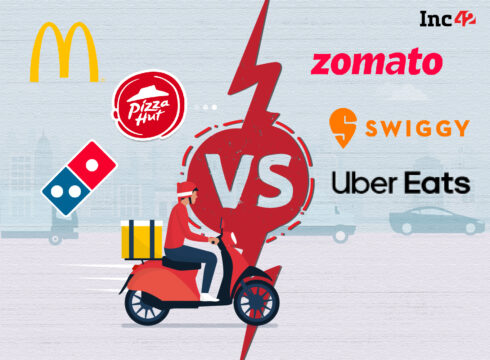Food Aggregators charge up to 30% of commissions on an order and this is a big pinch for the restaurant chains
The pandemic and online buying behaviour have forced large restaurant chains to focus on their own logistics for home deliveries
Automation technology is proving its worth by helping brands save on delivery costs by up to 20%
Inc42 Daily Brief
Stay Ahead With Daily News & Analysis on India’s Tech & Startup Economy
Food chains like McDonald’s, Domino’s and Pizza Hut are focussing on their own apps to drive direct traffic — this has been one of the trending topics on social media over the last week. But why?
Over the last few years, food aggregators have managed to change the habits of urban consumers. And the pandemic has accelerated this irreversible change of ordering stuff online — be it food, grocery, furniture or cars!
But along with getting the customers comfortable with the idea of shopping online, the past two years provided businesses with a means to speak & build relations with their customers directly. This combined with the high commission charges of 3rd party aggregators like UberEats, Zomato and more, is the major factor behind the focus of food chains shifting to their own apps.
The Big Shift Of Fast Food Chains!
Although dining at restaurants is going up again in 2022, there has been a dramatic shift in the way fast food chains look at their business.
Online delivery and drive-through pickups form a significant proportion of their revenues and it has become increasingly important to own, optimise and automate their own delivery management.
Needless to say, technology is the only way to help fast food chains do it.
Why Not Food Aggregators?
Commissions with a capital ‘C’.
In the quest for unit economics, food aggregators charge up to 30% in commissions from restaurants and this shaves off a big chunk of the profits for a restaurant. Food aggregators certainly bring in more volumes but with these kinds of margins, it forces a fast food chain to think about owning their own deliveries.
Apart from the margins, customer experience is another big reason. A lot of the time, especially with the rise of dark kitchens, the end customer doesn’t have clear communication with respect to where the food has been prepared because of multiple stickers on the packaging.
By handling their own deliveries, large fast food chains can maintain a consistent end customer experience.
Technology And Automation
To combat these issues, fast food chains are upping their technology game. This can be either done by building the entire technology inhouse or adapting existing delivery automation platforms such as LogiNext and Bringg.
However, there are several components of delivery management technology:
Delivery Driver Management
One of the crucial calls a fast food chain has to take is on managing delivery drivers. A lot of CXOs mull over the right mix between in-house drivers and 3rd party drivers — a tech platform helps them arrive at the right solution and increase delivery driver efficiency multifold.
Route Optimisation And Auto Allocation
Until very recently, fast food chains would usually assign orders to a driver once he or she is at the store, and the drivers would deliver orders according to their own routes. This, however, often leads to inefficiencies in the system.
Route optimisation technology and auto allocation orders can result in efficiency gains to the tune of 150% and above!
We’ve seen restaurants going from an average of one delivery every hour to three deliveries every hour per rider!
A Great Customer Experience
Along with reduced delivery times and greater efficiency, one of the biggest plus points of handling your deliveries is the complete control over the delivery experience — which is at par or better than that provided by 3rd party aggregators.
With the ability to have their custom branding on tracking links and running contextual promotions and offers, fast food chains can really up their game in terms of communicating in real time with their customers.
What Does The Future Hold
All in all, online ordering is an irreversible change that has set in. In-dine innovation will drive more people to fast food chains but online deliveries will remain equally critical and large fast food chains are right on their money by focussing on their own apps.
We can expect to see more fast food chains investing in tech platforms to bring their delivery management inhouse which would help them open up new revenue opportunities by utilising their drivers’ spare time.
This is a domain ripe for innovation and several progressive fast food chains are betting big on technology to up their revenue game and deliver a great customer experience.
Note: We at Inc42 take our ethics very seriously. More information about it can be found here.


